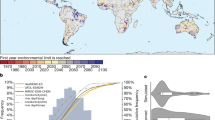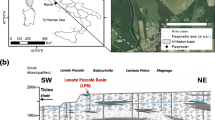Abstract
Infiltration (or recharge) is the ultimate source of groundwater, and controls mine inflow, groundwater supply, and flow and solute transport behavior in large-scale groundwater systems. However, infiltration is rarely directly measurable, and is difficult to quantify. An 18 square kilometer area at 3,000 meters above sea level in the Rocky Mountain Cordillera of North America has been de-watered for the last century by a system of drainage tunnels, which has provided a rare opportunity to directly measure infiltration. Infiltration to deep groundwater was found to average 175 mm per year to the district, or 39% of the total precipitation of approximately 445 mm per year. These infiltration rates are significantly higher than the normal range of 5% to 10% of total precipitation that are identified at lower altitudes in this region, due to the effects of altitude, temperature, storm intensity, and thin soil cover in the district.
Access this chapter
Tax calculation will be finalised at checkout
Purchases are for personal use only
Preview
Unable to display preview. Download preview PDF.
Similar content being viewed by others
References
Earthlnfo (1997). NCDC Summary of the Day, West 1 1997. CD-ROM Databases. Boulder, Colorado, USA.
Lindgren W, Ransome FL (1906) Geology and Gold Deposits of the Cripple Creek District, Colorado. United States Geological Service Professional Paper No. 54.
Miller JF, Frederick RH, Tracy RJ (1973) Precipitation Frequency Atlas of the Western United States, Volume III-Colorado. NOAA Atlas 2
Musgrave GW (1955) How Much of the Rain Enters the Soil? USDA Water Yearbook of Agriculture, Washington, D.C. pp 151-159.
Vivian CH (1941) Carlton Drainage Tunnel to Give Cripple Creek New Life. Colorado Bureau of Mines.
Pontius JA (1997). Field Guide-Gold Deposits of the Cripple Creek Mining District, Colorado, USA. Pikes Peak Mining Company
Peyton RL, Schroeder P (1994) The Hydrologic Evaluation of Landfill Performance (HELP) Model. EPA/600/R-94/168A.
Author information
Authors and Affiliations
Editor information
Editors and Affiliations
Rights and permissions
Copyright information
© 2002 Springer-Verlag Berlin Heidelberg
About this paper
Cite this paper
Brown, A. (2002). Infiltration to Groundwater at High Altitude. In: Merkel, B.J., Planer-Friedrich, B., Wolkersdorfer, C. (eds) Uranium in the Aquatic Environment. Springer, Berlin, Heidelberg. https://doi.org/10.1007/978-3-642-55668-5_108
Download citation
DOI: https://doi.org/10.1007/978-3-642-55668-5_108
Publisher Name: Springer, Berlin, Heidelberg
Print ISBN: 978-3-642-62877-1
Online ISBN: 978-3-642-55668-5
eBook Packages: Springer Book Archive




